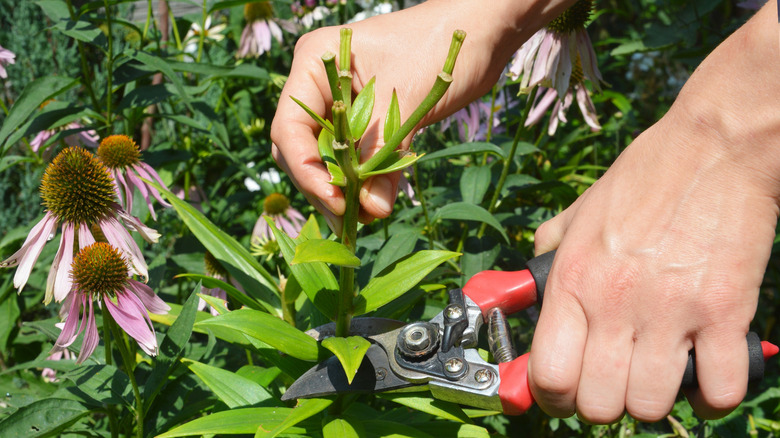The Best Way To Deadhead Lilies For Bigger & Better Blooms Next Season
If you've spent fall and winter protecting the lilies (Lilium) in your garden, it's not wrong to expect some extravagant blooms come spring and summertime. A stunning and captivating addition to any landscape, lilies are known for their elegant star-shaped petals and sweet scent. With over 100 species and the ability to grow in most climates, lilies can serve as a dazzling set-piece that will bring color to your garden. When they unfurl between June and September, it feels like a special event. And it really is — most of these popular and fragrant herbaceous perennials only bloom once a season. If you're wondering what to do after the show is over, deadheading — or removing spent blooms — is the answer. It's an essential part of upkeep, though it's important to make sure you're doing it correctly.
Deadheading in the garden is usually done for two reasons: One, on an aesthetic level, removing the wilted and faded blooms from your plants keeps your garden looking neat and pristine. Second, while deadheading lilies may not result in reblooming, it does allow the plant to store energy it can then use to produce bigger and better blooms next year. If you leave the wilted flowers on the stem and the plant has been pollinated, the plant will create seed pods. Your lilies will spend a lot of energy focusing on seed production, which means less resources for flower growth. If you want to promote vibrant growth for future seasons, it is critical to remove dying blooms by using pruning shears to cut the spike from the stalk at about a 45-degree angle.
The best way to deadhead lilies
Deadheading is very easy. The only required tools are pruning shears or scissors, depending on your preference. While most lily blooms start to fade after about a week, some varieties, like the Asiatic lily (Lilium asiatic hybrids), stay fresh for up to a month. That means once your lilies start showing off their gorgeous petals, make it a habit of checking your plants a few times during blooming season. Pay attention to any flowers that have dropped to a lower state and/or have discolored petals. Once you've located a wilted bloom, it's time to grab your pruning shears and get to work! As you make your cut, be sure to aim below the flower spike and above the first bunch of healthy leaves. Your lily plants need its leaves to absorb sunlight and make carbohydrates during its dormant seasons. Unless you notice browning or yellowing, the leaves should remain untouched until the fall.
Once you have removed the faded blooms, you can either toss them in the trash or compost them. Make it a point to clean and disinfect your shears after every cut; it's easy to introduce bacteria and other diseases to your plants using dirty tools. Additionally, avoid making sloppy or uneven cuts while deadheading, which can lead to infections. Though it may seem like an minuscule task, by removing dying flowers, your lilies will thank you later. Deadheading redirects energy towards the bulb, providing essential fuel that will be used for root development and flowering growth, ensuring bountiful blooms next year.

